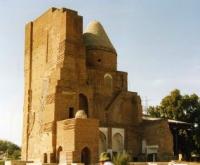Вы здесь
History Dorus Saodat.

Trip to architectural monuments of Shakhrisabz.
The building of the Ak-Saray palace gave effect to Sakhibkiran's idea of turning Shakhrisabz into the state's second capital, while the creation of the Dorus Saodat and Dorus-Tilyavat memorial complexes reflected his desire to make his home town the spiritual centre of Movarounnahr.
The Dorus Saodat "repository of power" memorial complex was intended for the whole Timurid dynasty and was founded after the untimely death of Timur's eldest son, Jahangir, at the age of 20.
Several years later, an extremely tall building, Jahangir's Mausoleum, was erected over the prince's grave with the help of craftsmen from Khorezm. Timur's court chronicler, Sharafiddin Yazdi, wrote: "On both the right and the left-hand side of the facade of that edifice he ordered that the building of makbarats (burial vaults) and new khazira should be completed for the emir-zade Jahangir and other descendants and nobles."
A vault intended for Timur himself was located on the mausoleum's longitudinal axis beneath the conical dome. Timur's second son, Umarshaykh, 29, who was killed in 1393 - 1394 during the siege of the fortress of Kurd in Iran and whose body was brought to Shahrisabz from Shiraz, is also buried in the Dorussaodat complex.
The Dorus Saodat buildings were destroyed when the forces of the Sheybanid ruler Abdullakhan II entered Shahrisabz in the second half of the 16th century. Of the ground-level structures, only the mausoleum of Jahangir survived.
The multi-chamber mosque of Khazrati Imam with a domed hall and a painted ayvan, or raised verandah, was built next to it in the mid - XIXth century. There were living quarters around the courtyard.
The Dorut-Ttilovat ensemble (XIVth - XVth centuries) grew up to the south-west of the Dorus Saodat on the edge of an ancient cemetery. It was there that Emir Taragay, Timur's father, who died in 1360 - 1361, was originally buried.
The building of the Ak-Saray palace gave effect to Sakhibkiran's idea of turning Shahrisabz into the state's second capital, while the creation of the Dorussaodat and Doruttilovat memorial complexes reflected his desire to make his home town the spiritual centre of Movarounnahr.
The Dorussaodat ("repository of power") memorial complex was intended for the whole Timurid dynasty and was founded after the untimely death of Timur's eldest son, Jahangir, at the age of 20. Several years later, an extremely tall building, Jahangir's Mausoleum, was erected over the prince's grave with the help of craftsmen from Khorezm.
Timur's court chronicler, Sharafiddin Yazdi, wrote: "On both the right and the left-hand side of the facade of that edifice he ordered that the building of makbarats (burial vaults) and new khazira should be completed for the emir-zade Jahangir and other descendants and nobles."
A vault intended for Timur himself was located on the mausoleum's longitudinal axis beneath the conical dome. Timur's second son, Umarshaykh, 29, who was killed in 1393 - 1394 during the siege of the fortress of Kurd in Iran and whose body was brought to Shahrisabz from Shiraz, is also buried in the Dorussaodat complex.
The Dorus-Saodat buildings were destroyed when the forces of the Sheybanid ruler Abdullakhan II entered Shahrisabz in the second half of the XVIth century. Of the ground-level structures, only the mausoleum of Jahangir survived.
The multi-chamber mosque of Khazrati Imam with a domed hall and a painted ayvan, or raised verandah, was built next to it in the mid - XIXth century. There were living quarters around the courtyard.
The Dorut-Tilovat ensemble (XIVth - XVth centuries) grew up to the south-west of the Dorussaodat on the edge of an ancient cemetery. It was there that Emir Taragay, Timur's father, who died in 1360 - 1361, was originally buried.
Behind the Dorus Siadat is a bunker with a wooden door lading to the crypt of Tamerlane , discovered in 1943, when a child playing football fell through the ground. The room, plain except for Karanic quotations on the arches, is nearly filled by a single stone casket.
One the stone were found encryptions related to the life of Amir Timur, which is why that it is believed that the crypt was intended for him.
Authority:
«The Guidebook on tourist places of interest of the Kashkadarya province». 2011.







